The fundamental reason behind organizing business meetings is to convey the rationale behind certain decisions undertaken by the company and to project the path the company is expected to tread on in the near future. It’s where discussions occur to make way for deliberated conclusions and agreed on action paths. Our sample business meeting agendas have dedicated sections for roll calls and minutes of the meetings, which helps maintain consistency in the agendas discussed. It provides an efficient outline for important meeting details that involved parties can use as helpful guide to follow through the session.
Business Meeting Agenda Template Sample
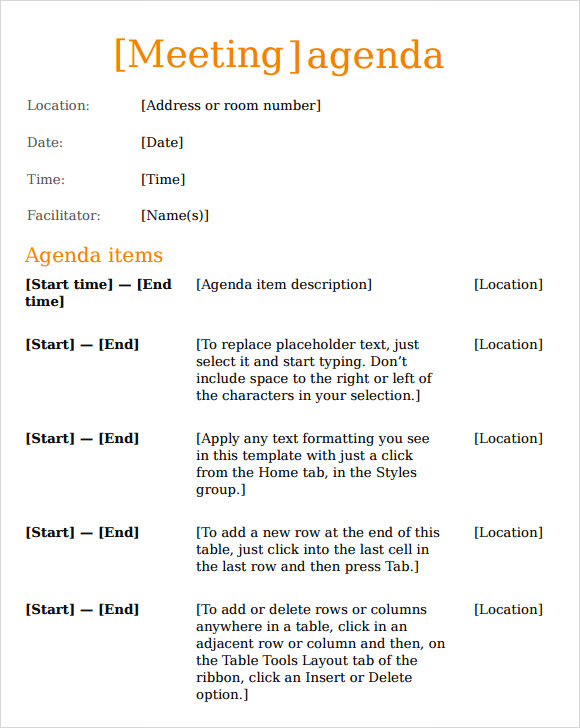
Business Meeting Agenda Template Doc
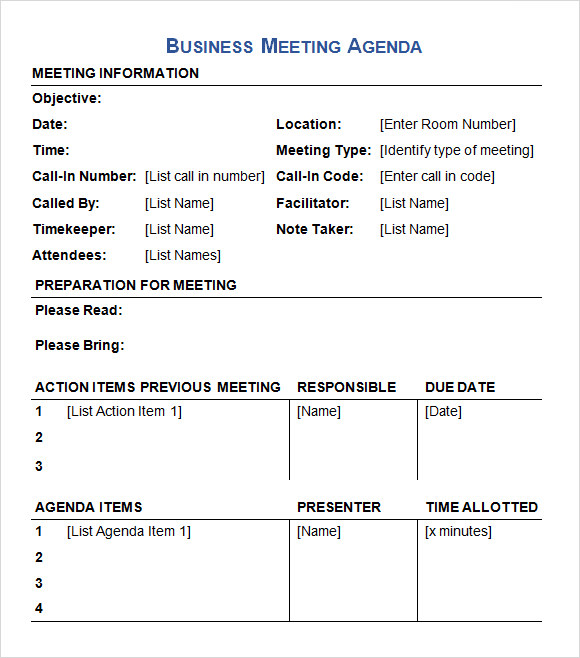
Business Meeting Agenda Template Example
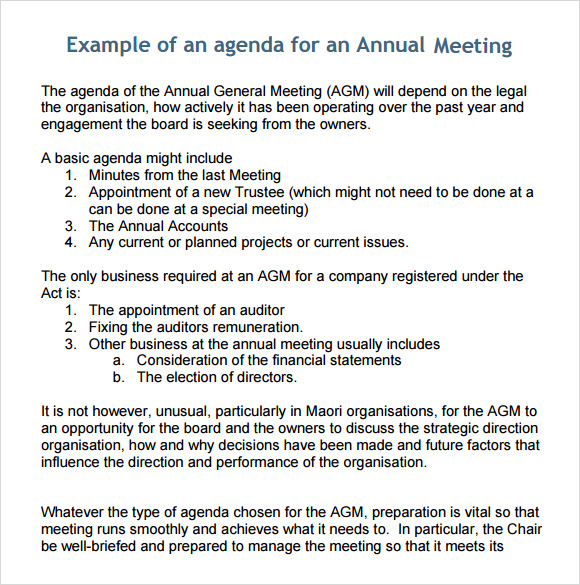
haltonhills.ca
Business Meeting Agenda Template PDF
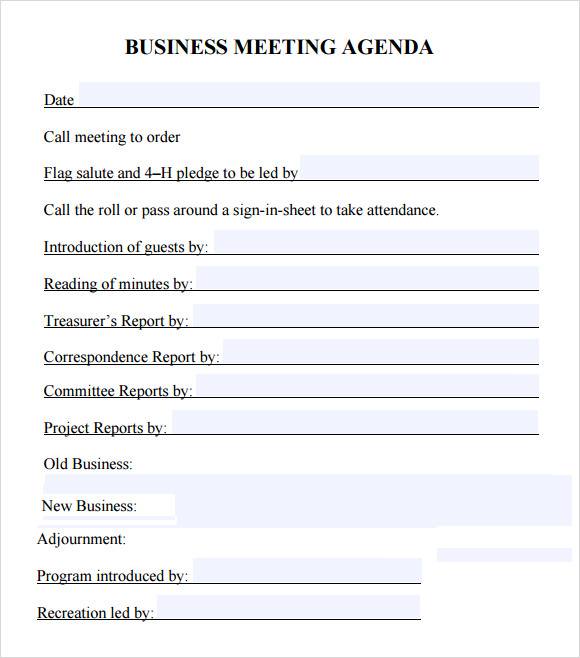
4h.ucanr.edu
Sample Meeting Agenda Template
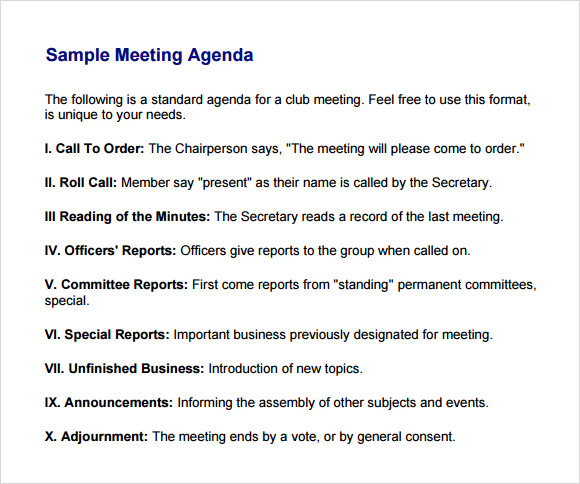
hacc.edu
Business Meeting Agenda Template Word

What Is a Business Meeting Agenda?
A business meeting agenda contains the outline of activities that will take place during a meeting session. It involves the objective of the discussion, related topics, and the progression of the discourse to help guide the flow of the gathering.
Why establish a meeting agenda when you can do an impromptu topic presentation during the meeting itself? According to Chron, agendas provide control. It helps the presiding individual to maneuver the discussion towards the right flow and cover all the important points without swerving to unnecessary subjects. Therefore, it’s easier to fit everything in a specific timeframe.
How to Write a Business Meeting Agenda
Here are some steps on how to make an efficient business meeting agenda:
Step 1: Fill in Relevant Meeting Logistics
Start by providing important details about the meeting agenda’s logistics. Specify when, where, and who will preside over the session. Identify which individuals, team, or department need to attend, so it’s clear who’s going to receive the meeting notice. Include the names of participants who need to present a report or material during the gathering. These details are important to those who’ll be joining, so be sure to verify all information beforehand to avoid confusion.
Step 2: Highlight the Agenda’s Goals
The meeting agenda’s objectives will sum up everything there is to talk about during the discussion. You must highlight what the meeting is all about, so it’s easier to map the topic flow of the session. It enables you to have fixed targets to address instead of going through everything without a concrete path of where the discussion is going to lead.
Step 3: Provide a Session Outline
The agenda outline is the arrangement of topics to be discussed from start to finish based on your session’s objectives. It will provide a clear path for how the meeting will go. It also allows the participants to know the main parts of the discussion. Identify what subjects you need to touch and create a sequence flow out of them to have logical discourse progress.
Step 4: Don’t Overload
Did you know that a goldfish has a better attention span than humans? A Time article says that a goldfish only has a nine-second attention span while humans can get easily distracted after eight seconds only. Would you expect to hold your participant’s attention for more than an hour? They may look attentive, but any details would be hard to retain after some time. Lengthy meetings are never efficient. Be conscious of the amount of topic you include on your agenda. Limit your meeting session up to twenty minutes at most.
FAQs
What do you need to include in a business meeting agenda?
Here are some things that are necessary for putting together a business meeting agenda:
- Information to be discussed
- Team tasks
- Agenda topics
Is the business meeting agenda the same as the minutes of the meeting?
No. The meeting agenda is a meeting plan of what’s going to happen during a session. On the other hand, a meeting minute is the summary of points written after the meeting is done.
What are the different types of business meeting agendas?
According to Bizfluent, the different types of meeting agendas are formal, informal, prioritized, and timed.
A business meeting agenda is a useful document to hold productive meetings. It keeps the session focused on accomplishing the discussion’s goals. This is only possible when you have an organized agenda flow. Look through our meeting agenda templates and get yours today!
Related Posts
Sample Meeting Minutes Templates
Presentation Speech Samples & Templates
Ukulele Chord Chart Samples & Templates
Retirement Speech Samples & Templates
Weekly Schedule Samples & Templates
Contractual Agreement Samples & Templates
FREE 9+ Amazing Sample Church Bulletin Templates in PSD | PDF
Sample Business Card Templates
Sample Cashier Job Descriptions
Questionnaire Samples
FREE 10+ Sample HR Resource Templates in PDF
FREE 10+ HR Consulting Business Plan Samples in MS Word | Google Docs | Pages | PDF
FREE 49+ Sample Job Descriptions in PDF | MS Word
FREE 16+ Nonprofit Budget Samples in PDF | MS Word | Excel | Google Docs | Google Sheets | Numbers | Pages
FREE 13+ Academic Calendar Templates in Google Docs | MS Word | Pages | PDF